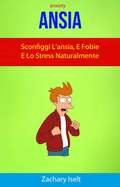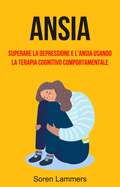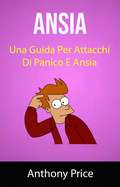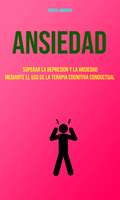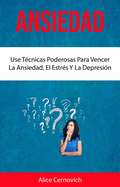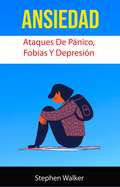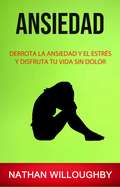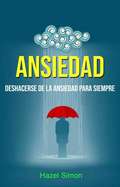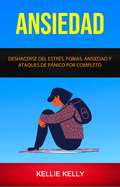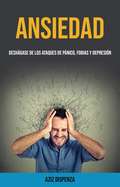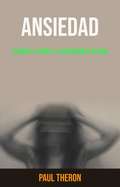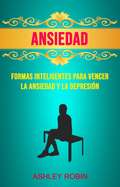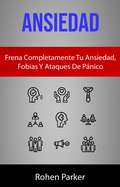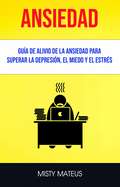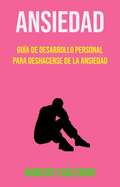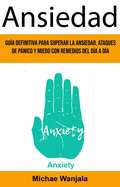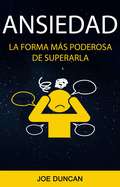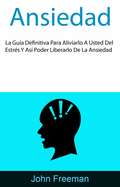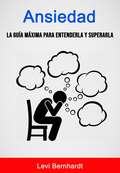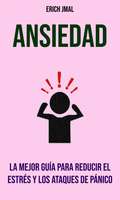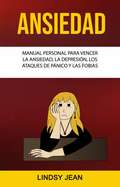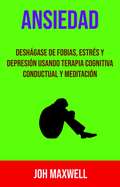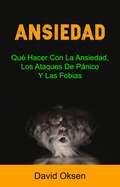- Table View
- List View
Ansia: Sconfiggi L’ansia, E Fobie E Lo Stress Naturalmente ( Anxiety )
by Zachary IseltLe davvero OTTIME NOTIZIE sono che Tu stai per scoprire come mettere fine all’infinito ciclo di depressione e ansia che domina la tua vita. Questo libro ti aiuterà a capire la depressione e l’ansia per aiutarti a conquistarle entrambe, in modo da vivere una vita piena e felice. È arrivato il momento di smettere di annaspare e iniziare ad imparare tecniche reali e conoscenze per trasformare il tuo panico, ansia e depressione nel coraggio per affrontare i demoni psicologici. Tutti abbiamo sperimentato nella nostra vita il dolore, ma la maggior parte delle persone vogliono uscire da quel posto oscuro anche se spesso non hanno la forza per farlo. e se potessi trasformare qualsiasi dolore attraverso il quale stai passando in libertà? Tutti gli esseri umani sulla faccia del pianeta hanno a che fare con stress e ansia, ma è come li gestisci che crea la differenza nella qualità della tua vita. Voglio che tu sappia che non sei solo in questo viaggio e che facendo qualcosa con gli esercizi presenti in questo libro i risultati non tarderanno ad arrivare. C'è una tecnica alla fine di ogni capitolo che leggerai e se le applicherai, ti guarderai trasformarti nella versione migliore di te senza paure. Prendi oggi la tua copia cliccando sul tasto all’inizio di questa pagina!
Ansia: Superare La Depressione E L'ansia Usando La Terapia Cognitivo Comportamentale
by Soren LammersDiversi anni fa ho scoperto di avere i livelli di mercurio eccessivamente alti a causa di una quantità di pesce superiore alla quantità raccomandata nella mia dieta. Ho immediatamente iniziato a fare ricerche sul problema per determinare se i miei alti livelli di mercurio potessero essere alla base di alcuni dei problemi di salute che avevo avuto. Lungo la strada ho scoperto qualcosa di incredibile. La mia lunga timidezza, l'ansia e l'imbarazzo per l'essere notato, stavano iniziando a dissiparsi. Ero più calmo in presenza di estranei e avevo livelli crescenti di fiducia me stesso. Ho studiato il mercurio e l' ansia sociale, ma ciò che ho scoperto è lontanissimo da ciò che immaginavo, ha scosso il mio mondo perché ho visto così tante cose che avrebbero potuto cambiare la mia vita se solo l'avessi saputo. Se hai problemi di ansia e mangi più di 2 porzioni di pesce a settimana, vorrei mostrarti i modi in cui l'uso storico del mercurio può essere rilevante per i tuoi problemi d' ansia nei nostri giorni.
Ansia: Una Guida Per Attacchi Di Panico E Ansia ( Anxiety)
by Anthony PriceIl libro tratta in dettaglio i sei principali disturbi dell'ansia: fobie, attacchi di panico e agorafobia; ansia sociale; disordine generalizzato dell'ansia; disordine ossessivo compulsivo; disordine post-traumatico da stress. Con un capitolo dedicato ad ogni disordine, Daniel e Jason Freeman ti portano attraverso i sintomi, le prevalenze e le cause di ognuno. Un capitolo finale descrive i trattamenti disponibili per affrontare i problemi dell'ansia. L'ansia è quello stato naturale della mente che ci avverte dei potenziali pericoli. L'ansia ha un ruolo nelle nostre vite e finché ne abbiamo un livello salutare e razionale, non influenza la nostra salute. Tuttavia, quando diventiamo ossessionati con un pericolo che è improbabile o irreale, l'ansia e gli attacchi di panico sono un nemico mortale. Immagina una vita in cui ti senti completamente in controllo dei pensieri nella tua testa e delle azioni che compi in relazione alle varie situazioni della tua quotidianità. Invece di guardare indietro ad azioni passate e chiederti perché ti sei comportato in un modo particolare, capirai perché l'ansia ti ha fatto fare qualcosa e come avresti potuto agire appropriatamente. La verità è che tutti talvolta reagiamo in risposta a una forza esterna che causa la nostra ansia. La differenza tra persone equilibrate che riescono ad affrontare la loro ansia e quelli più inclini a cadere vittima di un attacco di ansia è che le persone equilibrate semplicemente capiscono cosa serve per affrontare l'ansia. Anche tu avrai questa conoscenza a tua disposizione dopo aver letto questo libro.
Ansiedad : Superar La Depresion Y La Ansiedad Mediante El Uso De La Terapia Cognitiva Conductual
by Soren LammersReduzca el estrés, alivie el estrés, alivie el estrés, detenga el estrés, las técnicas de manejo del estrés, control del estrés, estrés y ansiedad, control del estrés, guía del manejo del estrés, cómo reducir el estrés, sobrelleve el estrés, libre de estrés, control del estrés para la vida, consejos para el manejo del estrés , control del estrés en el trabajo, alivio del estrés, estrés, estrés, vida, libro de estrés, estrés y ansiedad, libro de manejo del estrés, tratamiento del estrés, análisis de estrés, reducción del estrés, autoayuda de ansiedad, Programación neuro-lingüística de la PNL, Técnicas de PNL , Confianza, éxito, PNL para principiantes, curación de la depresión, PNL, cerebro, atraer dinero, atraer dinero ahora, más dinero, ley de la lotería de atracción, libros de PNL, el secreto, técnicas de PNL, PNL para principiantes, programación lingüística neuro neup, PNL Para dummies, nlp sales, nlp la nueva tecnología de logros, nlp master's handbook,entrenamiento nlp, autohipnosis para principiantes, auto hipnosis audio, auto hipnosis gratis, auto hipnosis a medida que lee, auto hipnosis para muñecos, libros de autohipnosis, ley de atracción, ley de atracción, ley de atracción amor, ley de atracción dinero, secretos de la ley de atracción, ley de la atracción biblia, hipnoterapia
Ansiedad : Use Técnicas Poderosas Para Vencer La Ansiedad, El Estrés Y La Depresión
by Alice Cernovich¿Y si los pensamientos que desencadenan la ansiedad de su hijo se neutralizan? ¿Qué pasaría si las mariposas en su estómago, el sudor en sus palmas y la mirada desesperada en sus ojos por ayuda fueran transformadas? ¿Y qué si ellos tuvieran las habilidades para afectar esta transformación ellos mismos? Este libro proporciona un camino para hacer precisamente eso. Todos se preocupan, pero si la preocupación se ha apoderado de su vida y ha tomado la forma de ansiedad y pánico, es hora de tomar el control y recuperar su vida. El cura de ansiedad comprobada del pionero psicoterapeuta Klaus Bernhardt ha ayudado a miles de pacientes a llevar una vida más tranquila y feliz más rápido. Si sufres de ansiedad general, ataques de pánico o ansiedad social. En esta historia, conocerás a Nelly Moon, que se pone extremadamente nerviosa antes de ir en autobús a la escuela. ¡Pensar en el autobús hace que Nelly se ponga nerviosa!
Ansiedad: Ataques De Pánico, Fobias Y Depresión
by Stephen WalkerLa ansiedad puede ser tan terrible que puede llegar a ser incapacitante hasta un punto en el que cada aspecto de tu vida se ve afectada. Sin embargo, con la ayuda de algunas prácticas simples en tu vida, es posible sobreponerte a la ansiedad, y como muchas otras condiciones en nuestras vidas, no hay mejor manera de luchar contra esta condición que la forma natural. Debes saber que no es tan complicado superar la ansiedad siempre y cuando tengas el conocimiento adecuado. ¡Estás a punto de descubrir como sobreponerte definitivamente a la ansiedad y crear un desahogo para ella de por vida! Tratar con un desorden de ansiedad puede ser uno de los problemas mas difíciles de afrontar y es una de las peores enfermedades conocidas por la humanidad. Habiendo dicho eso, dentro de este libro encontrarás métodos comprobados que han ayudado a otros como tú a superar su ansiedad y a crear una vida plena llena de paz y felicidad. No esperes más para descubrir LA CLAVE para una nueva y mejor vida.
Ansiedad: Derrota La Ansiedad Y El Estrés Y Disfruta Tu Vida Sin Dolor
by Nathan WilloughbyEste libro te ayudará a entender por qué te sientes ansioso. Ya sea que ocurra con frecuencia o solo durante un evento específico, encontrar la raíz de su problema es tan importante como tratarlo. La información que se proporciona en este libro lo ilustrará y lo educará sobre la ansiedad de manera integral. Al haber recibido capacitación sobre el tema, así como a mí mismo para vencer la ansiedad, encuentro que el material que se encuentra dentro de este libro tiene un alto contenido y es beneficioso para cualquiera que quiera comprender por qué tienen problemas de ansiedad. Superar estas fobias sociales es un evento que cambia la vida. Muchas personas describen sus vidas después de vencer la ansiedad social como sentirse completamente nuevo. Esta puede ser tu historia también. Las estrategias compartidas en este libro requieren tiempo y esfuerzo, pero será recompensado enormemente. Si está listo para actuar y cambiar su vida para mejor, ¡este libro definitivamente lo guiará en la dirección correcta!
Ansiedad: Deshacerse De La Ansiedad Para Siempre
by Hazel SimonEl cerebro humano es la pieza de maquinaria orgánica más compleja en el planeta tierra. Durante casi toda la historia ha sido malentendido y consistentemente rodeado de datos inexactos y falsedades opacas. Luego surgió el campo de la neurociencia y, desde su inclusión, más y más sobre el misterio del cerebro ha comenzado a salir de la oscura cueva de la confusión y salir a la luz de la comprensión. ¿Esto suena familiar? De mala gana, usted decide asistir a un evento de redes con un compañero de trabajo quien cancela en el último minuto. La idea de ir solo le llena de ansiedad debilitante. Teme una próxima entrevista de trabajo. Dar una presentación en el trabajo le mantiene despierto por la noche. ¡Obtenga su copia hoy haciendo clic en el botón en la parte superior de esta página!
Ansiedad: Deshacerse Del Estrés, Fobias, Ansiedad Y Ataques De Pánico Por Completo
by Kellie KellyEn tiempos en los que era una chica medio normal, Sadie nunca se preocupó por su salud mental. Pero en el momento en el que los tres demonios, la ansiedad, el pánico y la depresión comienzan a apoderarse de su vida, Sadie se pregunta si algún día volverá a ver la luz. Con Aldo a su lado, ¿será Sadie capaz de escapar del oscuro pozo sin fondo y recuperar el control de su vida? Una vez que has tocado fondo, solo hay una salida… El personaje de esta novela puede que sea ficticio, pero los sentimientos y emociones son muy reales. Aprovecha los avances en neurociencia para renovar tu cerebro y sentirte libre de las cadenas de la ansiedad, de la timidez y de los ataques de pánico. Si la ansiedad es la que dicta el camino de debes vivir y estás preparada para realizar un cambio y hacer cambios en tu vida, este libro te ayudará a superar la ansiedad. Los misterios del cerebro son tema de inversión investigación que buscan descubrir y definir comportamientos, tanto positivos como negativos.
Ansiedad: Deshágase De Los Ataques De Pánico, Fobias Y Depresión
by Aziz DispenzaA ese fin, ha sido escrito para discutir todo lo que necesitas saber para echar a tu ansiedad pase lo que pase si estás lidiando con un desorden de ansiedad generalizado, desorden de pánico, desorden de ansiedad social e incluso fobias. Aprenderas ejercicios practicos que puedes desplegar al momento que tu ansiedad este llameante, tambien como se acerca al largo plazo que va a facilitar tus cuestiones para lidiar con ellas diaramente. Tan pronto como intentas dar tus sugerencias cada día estás obligado a encontrar la plenitud que funcione para ti. Entonces, ¿qué estás esperando? Toma control de tu ansiedad de una vez por todas y compra este libro hoy!! Este libro contiene pasos y estrategias comprobados acerca de como reducir la ansiedad, los sentimientos nerviosos, y prevenir ataques de pánico. La ansiedd es un desorden que afecta a millones de personas cada día y que puede verdaderamente afectar en la persona y en la gente que la rodea. Si estás listo para accionar y cambiar tu vida para mejor, este libro te guiará definitivamente en la dirección correcta! Genero: Autoayuda
Ansiedad: Elimine El Estrés Y La Depresión De Su Vida
by Paul TheronHay maneras de superar tus sentimientos de ansiedad y liberar tu vida de estrés agregado innecesario. En este libro, encontrarás maneras de superar la ansiedad y los sentimientos que la acompañan. Lo creas o no, hay muchas maneras de ayudarte que no incluyen medicamentos prescritos. Amando la vida en la deslumbrante aldea de Alderley Edge, Sadie Valentine pensó que lo tenía todo. Con su mejor amigo gay, Aldo, como compañía, Sadie pasa su tiempo sorbiendo burbujas entre gente rica en sus muchos bares y restaurants locales. Sin embargo, desconocido para el mundo exterior, Sadie está combatiendo un corazón roto. Manteniendo su máscara puesta diariamente prueba ser más difícil de lo que Sadie anticipó y, cuando ella recibe más golpes, su exterior positivo comienza a desmoronarse. Sadie pronto se da cuenta que a veces no es tan simple levantarse y seguir adelante. ¡Consigue tu copia hoy hacienda clic en el botón de la parte superior de esta página!
Ansiedad: Elimine La Ansiedad, Estrés Y El Miedo De Su Vida Utilizando Mindfulness Y Meditación
by Peter DyerEsta guía práctica para entender los nervios craneales como la clave de nuestro bienestar psicológico y físico se basa en la teoría polivagal de Stephen Porges, uno de los desarrollos recientes más importantes en neurobiología humana. Basándose en más de treinta años de experiencia como terapeuta craneosacral y Rolfer, Stanley Rosenberg explora el papel crucial que juega el nervio vago en la determinación de nuestros estados psicológicos y emocionales y explica que hay una miríada de síntomas psicológicos y físicos comunes, desde ansiedad y depresión hasta migrañas y dolor de espalda: indica una falta de funcionamiento adecuado en el nervio vago. En las historias que contamos, el autor y terapeuta Scott Gornto nos muestra cómo romper el ciclo de suposiciones falsas que conducen a una ansiedad innecesaria. Al tomar el control de nuestras reacciones hacia las personas que nos rodean, podemos aprender cómo estar realmente presentes en nuestras vidas a medida que fomentamos las relaciones que más importan. Si está listo para tomar medidas y cambiar su vida para mejor, este libro definitivamente lo guiará en la dirección correcta.
Ansiedad: Formas Inteligentes Para Vencer La Ansiedad Y La Depresión
by Ashley RobinLa ansiedad y la depresión no discriminan. No importa cuál sea el color de tu piel, de qué nacionalidad eres, tus ideas políticas, cuál es tu género, cuál es tu orientación sexual y ni siquiera cuál es tu religión. También los psiquiatras y psicólogos la sufren. Existe un estigma en la sociedad en torno a la ansiedad y la depresión. Mucha gente las tiene, pero nadie quiere hablar de ello. Los que no la tienen, no saben cómo tratar a los que sí lo tenemos. Este libro te ayudará a encontrar tu propio camino para superarlas.
Ansiedad: Frena Completamente Tu Ansiedad, Fobias Y Ataques De Pánico
by Rohen ParkerEste libro muestra pasos comprobados y estrategias para identificar los síntomas de la ansiedad social y ataques de pánico y cómo superarlos con éxito. ¿Alguna vez has sentido que tu timidez te impide hacer las cosas que quieres hacer? ¿Tu ansiedad afecta la calidad general de tu vida? La ansiedad social y los ataques de pánico tienen el poder de paralizar tus momentos de felicidad y éxito. Pero lo más importante es que tienes el poder para superarlos. El libro explica exactamente por qué sufres ataques de pánico e incluso por qué tus episodios pueden haberse convertido en un trastorno de pánico en toda regla. Explica por qué las personas terminan teniendo la condición de trastorno de ansiedad, comenzando con factores biológicos naturales, experiencias pasadas y la principal que es la cognición distorsionada simple. La forma en que manejes tu trastorno dependerá del origen previo de éste. Entonces, en última instancia, deberás poder focalizarte en la perspectiva correcta, incluso cuando te enfrentas a situaciones que son amenazantes.
Ansiedad: Guía De Alivio De La Ansiedad Para Superar La Depresión, El Miedo Y El Estrés
by Misty MateusSi alguien no actúa ante los síntomas de la ansiedad, con el tiempo se desarrollará en miedo, en consecuencia, cuando se convierta en una enfermedad mental severa afectará tus actividades cotidianas. Todo empieza desde tener conciencia sobre la ansiedad para poder ganar la batalla en contra de ella. En esta edición completamente revisada y actualizada del éxito del bestseller, que ha vendido cerca de un millón de copias alrededor del mundo, verás evidencia científica sobre como tu ansiedad, depresión, ira, obsesión o impulsividad puede estar relacionada a cómo trabajan ciertas estructuras especificas en tu cerebro. No debes quedarte con el cerebro que naciste, renómbralo. La clave para superar la ansiedad empieza por reconocerla, para que puedas tratar algo tienes que saber que es, su origen y por qué lo tienes. La mayor parte del tiempo, con solo saber los síntomas de la enfermedad es una gran ayuda para superar el problema. En este libro, se te proveerá toda la información que necesitas saber sobre la ansiedad. A la par de eso, su origen y la razón de porque la tienes, también conocerás los síntomas más comunes, la mejor forma de superarla y otros aspectos importantes que debes tener en cuenta para deshacerte de la ansiedad para siempre. ¡Desplázate hacia arriba para comprar tu copia hoy mismo!
Ansiedad: Guía De Desarrollo Personal Para Deshacerse De La Ansiedad
by Marco Eagleman.Hattie Cooper, la bloguera detrás de La guía dietética para chicas con ansiedad conoce sobre el tema. Ella ha vivido con Trastorno de Ansiedad Generalizada por años. Leer este libro es como recibir consejos de un amigo que ha estado en tus zapatos. Hattie comparte estrategias inmediatas y sencillas de seguir para acabar con el TAG y desarrollar hábitos saludables. Con la asesoría del experto y psicoterapeuta registrado, Kyle MacDonald, quien es también el escritor del prólogo, las herramientas en estas páginas te ayudarán a superar tu ansiedad y revelar tu seguridad interior. La ansiedad ha estado presente desde que el cerebro humano existe. Como el cerebro, la ansiedad así como todos los demás conflictos asociados con ella también han permanecido como un misterio. A medida que la neurociencia ha ganado más impulso, también lo ha hecho nuestro conocimiento de por qué la ansiedad ocurre en primer lugar. Con la ayuda de los neurólogos, hemos empezado a entender la verdad de lo que sucede exactamente dentro del cerebro humano cuando la ansiedad comienza a tomar el control. ¡Descarga este grandioso libro hoy!
Ansiedad: Guía Definitiva Para Superar La Ansiedad, Ataques De Pánico Y Miedo Con Remedios Del Día A Día (Anxiety)
by Michae WanjalaUse los desarrollos en la neurociencia para reconfigurar el cerebro y desprenderse de la carga de la ansiedad, timidez y ataques de pánico. Si la ansiedad dicta la forma en la que vives y estás listo para cambiar y tomar el control de tu vida, este libro te ayudará a superar la ansiedad. Los misterios del cerebro aún continúan siendo estudiados para encontrar y definir un comportamiento positivo y negativo. La ansiedad ha estado presente desde que existe el cerebro humano. Como el cerebro, la ansiedad y todos los conflictos asociados a ella también siguen siendo un misterio. A medida que la neurociencia ha ganado más terreno, también lo ha hecho nuestro conocimiento de por qué la ansiedad sucede. Con la ayuda de neurólogos, hemos empezado a entender qué es la que realmente sucede dentro del cerebro humano cuando la ansiedad tiene el control. No esperes más para descubrir LA CLAVE para una nueva y mejor vida.
Ansiedad: La Forma Más Poderosa De Superarla
by Joe DuncanTODOS lidiamos con la ansiedad. Algunos luchamos más que otros, pero todos, de una forma u otra, tenemos que lidiar con este sentimiento. No se estrese, usted puede aprender a lidiar con su ansiedad y recuperar el control de su vida. Este libro presenta 30 consejos y estrategias fáciles de implementar que usted puede comenzar a hacer HOY para vencer su ansiedad. ¡Empiece a vivir la vida que usted quiere vivir! Si desea vencer esta enfermedad mental y recuperar su salud, necesita este libro. A veces, todo lo que se necesita para empezar a avanzar es leer historias de otras personas que también están luchando con los mismos síntomas que usted (o sus seres queridos).
Ansiedad: La Guía Definitiva Para Aliviarlo A Usted Del Estrés Y Así Poder Liberarlo De La Ansiedad
by John FreemanTal como son nuestras vidas hoy en día, es natural que todos enfrentemos algo de estrés y ansiedad. Pero cuando este pánico se vuelve abrumador y le impide vivir su vida, ¡es hora de actuar y controlar su ansiedad! Con esta guía única, puede aprender todo sobre la ansiedad y los trastornos relevantes para que pueda controlar sus emociones y llevar una vida tranquila. ¿Cuál es la diferencia entre la ansiedad y la depresión? ¿O pánico y miedo? ¿Cuáles son los síntomas y las causas de la ansiedad, y qué la hace diferente del estrés regular? En este asombroso libro, encontrará las respuestas a estas preguntas, junto con mucha más información, todas respaldadas por investigaciones científicas, que lo ayudarán a aliviar la ansiedad y cuidarse a sí mismo. ¿Qué esta esperando? ¡No espere más! ¡Diríjase hacia arriba y haga clic en el botón comprar ahora para comenzar el viaje a la vida de sus sueños!
Ansiedad: La Guía Máxima Para Entenderla Y Superarla.
by Levi BernhardtUn útil libro que nos enseña las verdaderas dificultades de la ansiedad y, sobretodo, cómo vencerla nosotros mismos mediante la perseverancia y el entendimiento.
Ansiedad: La mejor guía para reducir el estrés y los ataques de pánico.
by Erich JmalAprender a aplacar tu mente subconsciente que siempre trae pensamientos negativos que causan emociones negativas como depresión, enojo, frustración y más. ¿Estás listo para estar libre de ansiedad? Luego presione el botón comprar en la parte superior de esta página y comience su viaje de recuperación de inmediato.
Ansiedad: Manual Personal Para Vencer La Ansiedad, La Depresión, Los Ataques De Pánico Y Las Fobias.
by Lindsy JeanNo es que usted no tenga derecho alguno en cualquier relación que mantenga y que todo debería de hacerse siempre tal y como su amigo o familiar desean que se haga. Sólo digo que la mayoría de las veces tendrá paz cuando deje que su amigo o compañero sea el que deba aprender a cuidarse a sí mismo con el fin de evitar la ansiedad. El capítulo uno se centra en diagnosticar y en cómo puede ayudar a reducir la ansiedad al cambiar las perspectivas de una persona. Este método se puede llevar a cabo con éxito para controlar los factores psicológicos que producen la ansiedad. El capítulo dos aborda las recomendaciones en la alimentación que se pueden aplicar para reducir la ansiedad dentro del aspecto físico. El método para controlar o eliminar la ansiedad debe ser global, especialmente cuando no hay una causa específica. Descubrir el método ideal se convierte en una cuestión de prueba y error, pero es un esfuerzo que debe hacerse. Si está listo para actuar y cambiar su vida para mejorar, ¡este libro definitivamente lo guiará por el camino correcto!
Ansiedad: N/A
by Joh MaxwellSi ha tenido que lidiar con el trastorno de ansiedad crónica en algún momento de su vida o ha visto a alguien que padece esta afección, comprenderá por qué requiere seria e inmediata atención. El trastorno de ansiedad se encuentra entre las afecciones mentales que se ignoran fácilmente y sus efectos debilitantes de gran alcance son enormemente resaltados. La ansiedad puede hacer que se pierda de toda la diversión y de la alegría de la vida. Puede hacer que se detenga por temores infundados y hacer que se preocupe por cosas que nunca podrían suceder. La ansiedad te hace creer que siempre hay algo siniestro acechando o una gran desgracia que le espera. Vivir una vida así no es vivir en absoluto y por eso escribí este libro. Si está listo para actuar y cambiar su vida para mejor, ¡este libro definitivamente lo guiará en la dirección correcta!
Ansiedad: Qué Hacer Con La Ansiedad, Los Ataques De Pánico Y Las Fobias
by David OksenEl mejor curso de acción a seguir es no aferrarse demasiado a las cosas. Aprender a dejar ir las cosas es uno de los principios más importantes para dominar para alguien que sufre de ansiedad. Aprender a dejar ir muchas cosas en la vida (no solo los problemas que rodean a la persona que sufre de ansiedad) te ayudará a tener una vida mucho más feliz, punto. En este capítulo, revelaré algunas excelentes maneras de dejar ir las cosas en la vida. La ayuda está disponible para aquellos que sufren de ansiedad y esto viene en forma de iniciativas naturales y prácticas que pueden implementarse sin necesariamente recurrir a medicamentos recetados. Los siguientes capítulos proporcionan información útil sobre cómo manejar la ansiedad. Obviamente, lo ideal es eliminar por completo esta condición perturbadora y el uso concienzudo de las técnicas discutidas hacen que esta sea una posibilidad distinta.
Ansiedad: Remedios Para Eliminar La Ansiedad Completamente
by Max MangalDescubrirás cómo las personas son diagnosticadas con ansiedad y qué es lo que desencadena los ataques de pánico. Se han realizado numerosos estudios sobre el tema y aprenderás cómo la ansiedad afecta a la sociedad en su conjunto. Te sorprenderá saber cuántos estadounidenses sufren de ansiedad y ataques de ansiedad. No es algo de lo que todos hablen y apuesto a que la mayoría querré mantenerlo en secreto. Sin embargo, la ansiedad y los ataques de pánico son un problema grave. He elaborado este libro porque yo mismo he sufrido de ansiedad y ataques de pánico y quería ayudar a educar a las personas que podrían estar pasando por algo similar.
